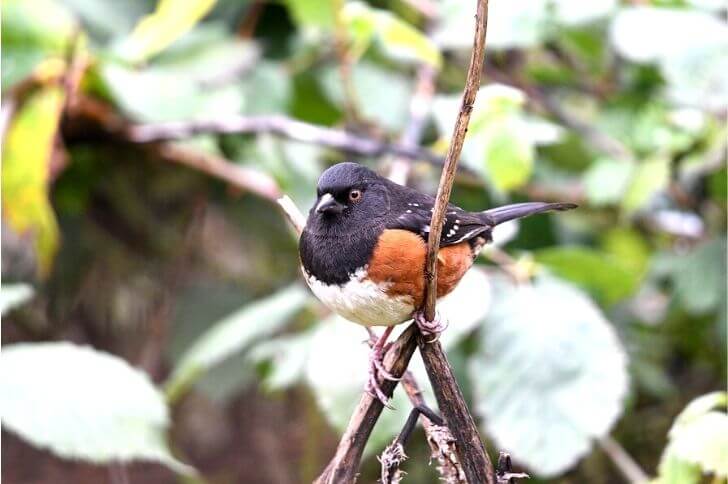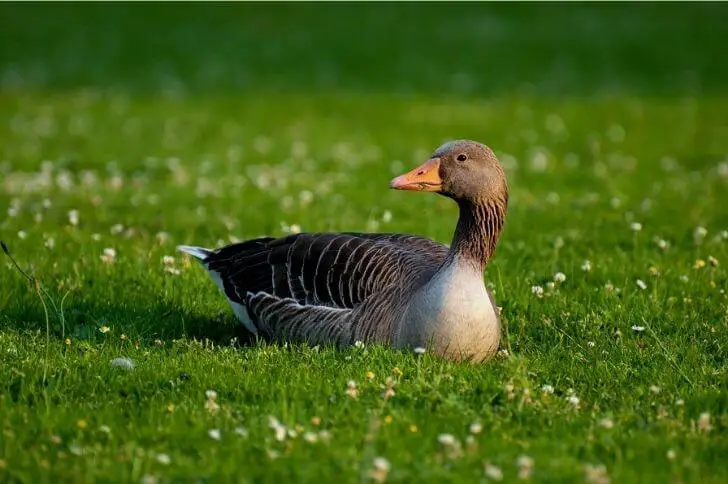How many black birds with white chests do you know? From the white-breasted nuthatch to most birds in the woodpecker family, there are over 300 bird species that have this unique plumage.
And, to make things interesting, in the list below we’ve included birds in the United States as well as those found in other parts of the world. Whether you are planning to go bird watching in the US or a Safari to Africa, here are the most common white breasted black birds that you will see.
List of Black and White Birds
1. White-Breasted Nuthatch
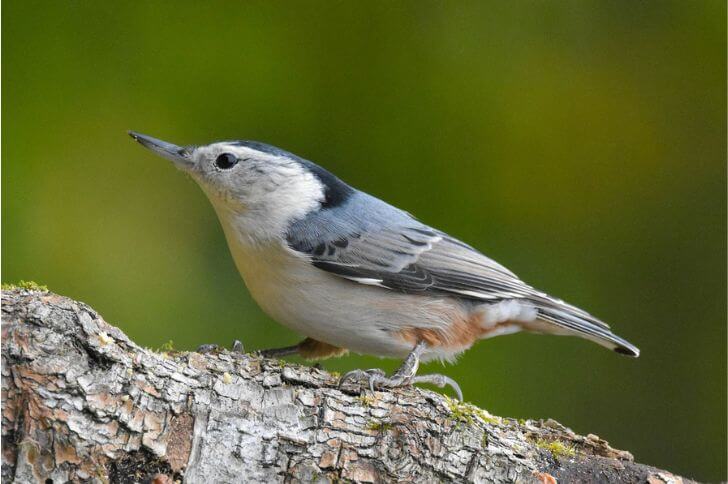
This little bird is a common sight at backyard feeders and in forests across North America.
Identification:
The white-breasted nuthatch is easily recognized by its blue-gray upperparts, black-tipped wings and white breast. It has a black cap and a long black stripe running down its neck.
The white-breasted nuthatch is a small songbird measuring about 4-5 inches in length. It has a wingspan of about 6-8 inches.
Interesting facts:
This bird gets its name from its habit of wedging nuts into cracks in tree bark and then “hatching” them open with its strong beak.
Between May and June, female white-breasted nuthatches will lay up to six eggs which need two weeks of incubation. At one months, the nuthatch juveniles are ready to leave the nest.
2. Eastern Towhee

The eastern towhee is a beautiful bird that is native to North America. It is a member of the Sparrow family and its scientific name is Pipilo erythrophthalmus.
Identification:
This small black bird with white chest is easy to identify. The adult male eastern towhee has a black back, wings, and tail with white edges. The underparts are white with rufous on the sides. The head is black with a white spot on the cheek and a red eye.
The juvenile and female eastern towhee looks similar to the adult but they have brown instead of black feathers on their head, back and wings.
Interesting facts:
The eastern towhee can be found in woods and forests throughout much of the eastern United States. It prefers habitats with dense understory vegetation such as young forests, shrubby areas, and thickets.
The song of this black and white bird is a series of notes that sound like “drink-your-tea”. Their calls are a series of “tow-hee” and “chewink” notes.
3. Eurasian Magpie

A member of the crow family, the Eurasian magpie is a common and conspicuous bird across Europe and Asia. How can you tell it apart from other birds in its family?
Identification:
Unlike other birds, this large black and white bird is very showy. With its loud calls and fondness for open space, it’ll be hard to mistake it.
It is a medium-sized bird, 17-18 inches, with black and white plumage. Its head, undetail, rump, and long tail are black. Below, its white and black with iridescent wings.
Interesting facts:
The magpie is a highly intelligent bird that can mimic the calls of other birds and animals. The Eurasian magpie is considered to be a nuisance by some people because it will steal food from picnics and garbage cans.
During their breeding season, Eurasian magpies lay speckled eggs that take about three weeks to hatch.
4. White-headed Woodpecker
There are many different types of woodpeckers, but the white-headed woodpecker is one of the most interesting. Members of this family share similar coloring and here is how you can identify the white-headed woodpecker.
Identification:
About 7.9 inches in length, it is a medium-sized bird. This bird is mostly black with a white head and chest.
Males have a small red crown at the back of the head. Females do not have this crown. Note the white stripe at the outer part of each wing.
Other facts:
It has a very loud call, rapid “pee-kik” sounds. The white-headed woodpecker is found in forests across North America.
This bird is known for its acrobatic abilities. It can often be seen hanging upside down from tree branches. The white-headed woodpecker eats insects, which it finds by pecking holes in trees.
This black and white bird is a beautiful bird that is interesting to watch. If you’re lucky enough to see one, you’ll never forget it!
5. Black-Capped Chickadee
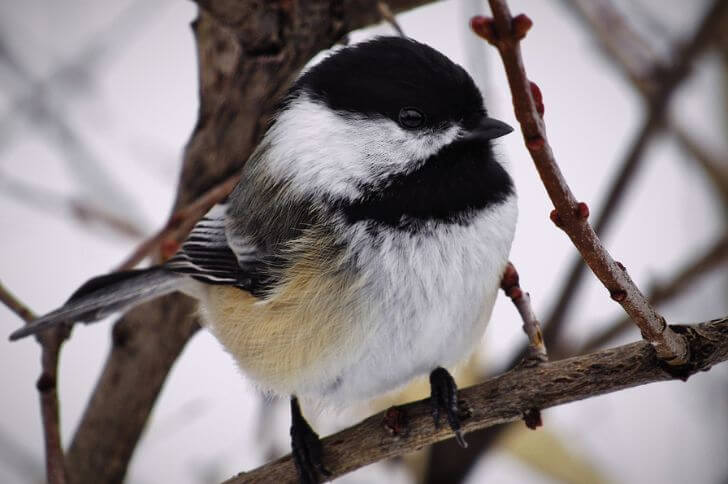
The black-capped chickadee is a beautiful song bird that is wonderful to watch. This small bird is known to frequent bird feeders.
Identification:
The adult has a black cap and bib with white sides to the face. Its back and wings are gray, and its tail is black about and pale below. Black-capped chickadees have white bellies. Also, notice the black throat.
Other facts:
Black-capped chickadees are found in woodlands, parks, and gardens throughout North America. They eat insects, spiders, berries, and seeds. Chickadees are social birds that live in small flocks year-round.
Black-capped chickadees are well known for their ability to survive cold winters. They have several adaptations that help them withstand low temperatures, such as thicker feathers and the ability to lower their body temperature at night.
Chickadees also hoard food in the fall, storing thousands of seeds in tree cavities to eat during winter months.
6. Eastern Kingbird
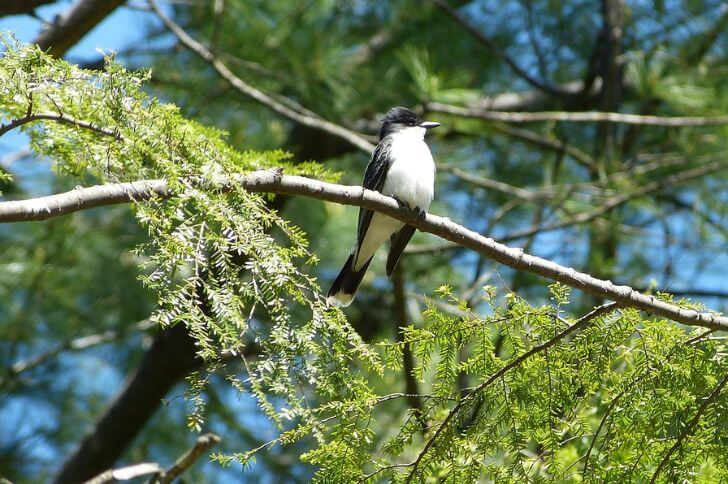
Eastern kingbirds are beautiful birds that are found in eastern North America. What does this bird look like?
Identification:
The adult Eastern kingbird has a black body with a white chest and belly.Wings are black with noticeable white wing bars. Also, its has a white-tipped black tail.
This small bird boasts of a black bill and strong grayish leg. The female Eastern kingbird looks similar to the male, but she has a brownish body.
Interesting facts:
The Eastern kingbird is an insectivore. He eats mostly flying insects such as bees, wasps, flies, beetles, and grasshoppers. He will also eat some fruits and berries.
The Eastern kingbird nests in trees or shrubs near open areas where there are lots of insects for him to eat. He uses twigs, leaves, and grass to build his nest.
During nesting season, these birds build well-hidden nests where the female lays 3-5 0.8 inch eggs. Fledgling takes place after three weeks.
7. Pied Crow

If you are going for a safari in Africa, here is a large black bird with white chest that is very common in urban space, the pied crow.
Identification:
How big is a pied crow? A member of the corvidae family, the pied crow is the same size as the American crow; 16-20 inches.
An adult has a black glossy head, back and undertail. It has a white chest and collar. Its long tail, wings and bill are black too.
Other facts:
The pied crow is found in wooded areas and open savannas. It mainly feeds on insects, small mammals, reptiles, and eggs.
This black and white bird builds nests in trees or on cliffs, where females lay three to six heavily spotted eggs. The pied crow is considered to be a pest by many farmers because it feeds on their crops.
8. Ring Ouzel
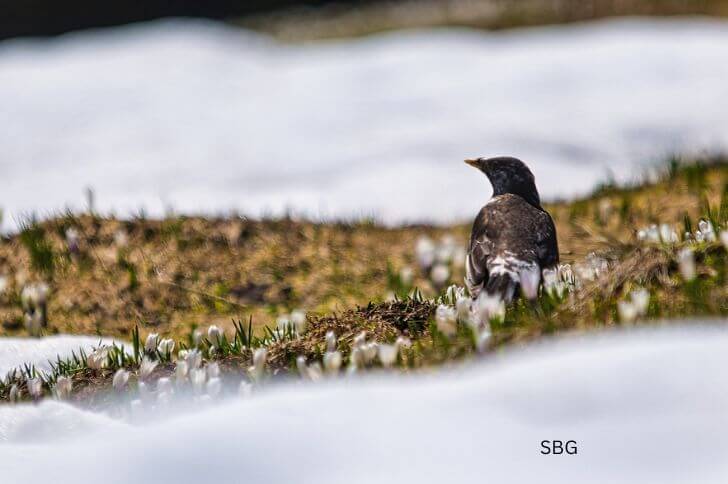
A ring ouzel is found in the mountains of Europe and Asia, where it feeds on insects and berries. Ring ouzels are shy birds that are seldom seen by humans.
Identification:
Which family does the ring ouzel belong to? The thrush family. Adults are overall black with white markings on their wings. Males have a white patch around their breast while the female’s is duller. Immature birds are duller.
Other facts:
The bird gets its name from its song, which sounds like a ringing bell. It consists of “tri-iii” sounds repeated at least three times. Ring ouzels are shy birds that are seldom seen by humans.
9. Spotted Towhee

Similar in size to the Eastern towhee that we looked at above, the spotted towhee is a North American bird in the sparrow family. It is a large songbird known to visit backyards with overgrown or shrubby borders.
Identification:
With a long tail and distinctive rufous sides, these small black birds are a wonderful sight to watch. The adult spotted towhee male is black above, rufous on the size, and white below. Females are duller.
Both sexes have white spots on their wings which gives them their name. Both sexes have stunning red eyes.
Interesting facts:
The spotted towhee is found in forests and woodlands across much of western North America, from Alaska to Mexico.
It is a shy and solitary bird, most often seen foraging on the ground for insects or seeds. The spotted towhee is an important part of the forest ecosystem, providing control of insect populations and dispersing seeds that help to regenerate the forest.
10. Hairy Woodpecker

Large and easily recognizable, hairy woodpeckers are resident breeders in parts of North America. They are easily recognized for their loud calls, which can often be heard echoing through forests.
Identification:
What does a hairy woodpecker look like? You can recognize them by their black and white spotted plumage, as well as their red caps for the males. Females do not have the red patch on the head but also spot a white belly.
Interesting facts:
Hairy woodpeckers are found in both deciduous and coniferous forests across North America. They typically nest in cavities that they excavate themselves. These birds feed on a variety of insects, as well as nuts and berries.
You can attract them into your yard using suet and peanut feeders. They are known for their hammering sounds and are known to defend their territory.
11. Black-Throated Gray Warbler
The black throated gray warbler is a beautiful bird that is endemic to North America. Sociable and melodious, these small black and white birds are easy to spot.
Identification:
The adult male has a black throat, white upper breast and belly. The rest of the body is a soft gray and white with black bold streaks. Females are similar in plumage with a paler throat. Notice the bright yellow spot close to the eye.
Interesting facts:
The black throated gray warbler is a shy bird that is often found in trees near the edge of forests. It eats insects and spiders, which it catches by flicking its long tail from side to side. The black throated gray warbler is not currently considered to be at risk of extinction.
12. Carolina Chickadee

There are few birds as recognizable as the Carolina chickadee. These small, black and white birds are a common sight in backyards and parks across the southeastern United States.
Identification:
Carolina chickadees are small birds, measuring only 4-5 inches in length. They have black heads, throats, and wings, with a white chest and belly. Chickadees have a large head relative to their body size, and a stubby tail. Note the white cheeks.
Other facts:
Chickadees are known for their friendly demeanor and their distinctive “chick-a-dee” call. Chickadees are social birds, often seen in small flocks of 6-10 individuals. They are active birds, constantly moving about in search of food. Their Carolina Chickadees diet is made up of insects and other small invertebrates.
13. Downy Woodpecker

Another North American black bird with white chest is the downy woodpecker. It is one of the smallest birds in this family and can easily be mistaken for the hairy woodpecker.
Identification:
It is the most widespread woodpecker in the continent, and is found in both deciduous and coniferous forests. You can also spot them in vacant lots and parks.
One average, this small bird is about 5.5-6.7 inches long. The male has a red patch on the back of its head, while the female doesn’t. Both sexes have black and white stripes on their faces, black wings with white spots and white underneath.
Other facts:
The downy woodpecker feeds on insects, which it finds by drilling holes into tree bark. It also eat berries and nuts. The downy woodpecker is an important part of the forest ecosystem, as it helps to control insect populations.
During their nesting period, they’ll raise one brood of 3-7 babies. They leave the nest after three weeks.
14. Red-Bellied Woodpecker
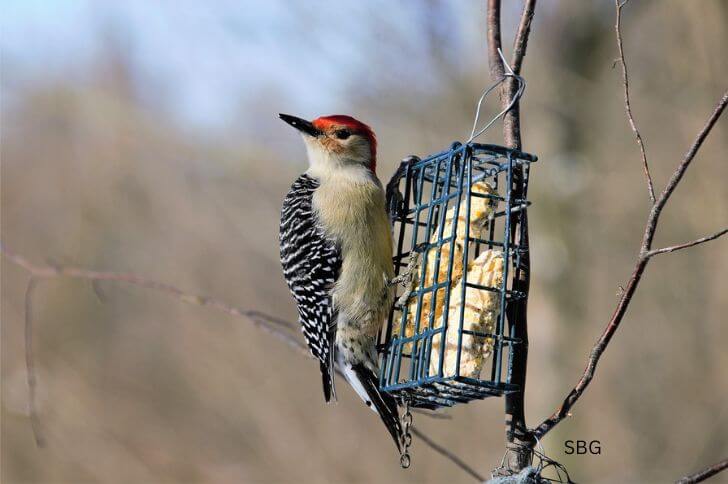
The red bellied woodpecker is a beautiful bird that you can attract to your backyard using sunflower seeds or peanuts.
Identification:
These birds are known for their striking red plumage on the head and their distinctive call. The red bellied woodpecker is a medium sized bird, measuring about 9 inches in length. They have black and white barred upperparts with a white throat and belly. The males have a brilliant red cap, while the females have a duller cap.
Do red-bellied woodpeckers actually have red bellies? Nope, Their bellies are white.
Other facts:
The diet of the red bellied woodpecker consists mainly of insects, which they find by drilling holes into trees. The red bellied woodpecker is an important part of the ecosystem, as they help to control the insect population.
Like other members of its family, it’s known for its hammering sounds, around 17-19 beats per second. The red bellied woodpecker is a popular bird among birdwatchers and nature enthusiasts.
15. Black Phoebe

Is a black phoebe a flycatcher? Yes, it is a member of the tyrant-flycatcher family. And like most birds in this family, it is small in size.
Identification:
These birds are small in size, about six inches long with a wingspan of 10.5 inches. The adult is dark above and white underneath.
Other facts:
They are very vocal and have a distinctive call. Black phoebes are known for their nesting habits, which involve placing their nests on ledges or in tree cavities. These birds typically lay four eggs per clutch, and they incubate their eggs for about two weeks. The young chicks fledge at around three weeks of age.
Black phoebes are interesting birds to observe, due to their unique behavior and appearance. If you find yourself near one of these birds, take the time to watch it and listen to its call. You may be lucky enough to see it build its nest and raise its young!
16. Black-winged Stilt
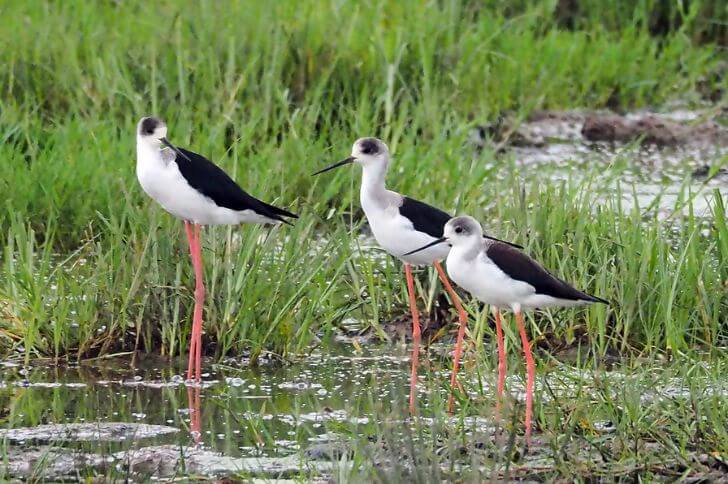
The black-winged stilt or the Himantopus himantopus is a wading bird in the family Recurvirostridae. It occurs in Africa, Europe, Asia, Australia, and New Zealand.
Identification:
The black-winged stilt has long red legs and a long narrow bill. The adult is white above and below with a black cap on its head. The wings are black. The juvenile is brown above with paler underparts.
Other facts:
The black-winged stilt breeds in marshes, swamps, and lakes. It nests in a scrape on the ground lined with vegetation. The female lays 2-4 eggs which are incubated for 21-24 days. Both parents care for the young birds which fledge at about 30 days old.
17. Black and White Warbler

Small and vibrant, the black and white warbler is a songbird of the New World warbler family. It is one of the most widespread warblers in North America, breeding in nearly every state and city.
Identification:
The black and white warbler is a small songbird with a heavily streaked black and white body. It has a short tail and legs, and its bill is long and pointed.
Other facts:
The black and white warbler is an insectivore, feeding primarily on caterpillars. It nests in trees, often near the ground in a cup-shaped nest made of leaves, twigs, bark, moss, and spider webs. The black and white warbler is not considered to be at risk of extinction.
18. Blackpoll Warbler

Where do blackpoll warblers live? They prefer boreal forests of North America. What does this bird look like?
Identification:
The Blackpoll Warbler is a small songbird that is about 5 inches long. The adult male has black and white plumage, similar to the black and white warbler above but with thinner streaks.
Also note their wings have a yellow-greenish tinge. In contrast the breeding female is grayish with brown upper parts and orange legs.
Interesting facts:
The Blackpoll Warbler is insectivorous. The bird nests in trees, and the female lays 3-5 eggs per clutch.
The Blackpoll Warbler is a long-distance migrant, wintering in Central and South America. The bird undertakes one of the longest migrations of any songbird species, flying non-stop for up to three days across the Atlantic Ocean.
19. Black-billed Magpie

Brilliant and entertaining, black-billed magpies are a common site in Northwest America. It can be found in open woodlands, farmlands, and even urban areas.
Identification:
The black-billed magpie is a large songbird with a long tail and iridescent black and white plumage. The adult bird has a black bill and eyes. Note the iridescent blue-green wings and tail feathers.
Other facts:
The Black-billed magpie is an opportunistic feeder and will eat just about anything it can find. This includes insects, small rodents, berries, fruits, and garbage. The Black-billed magpie is also known to steal food from other animals such as squirrels, hawks, and even humans!
20. Red-headed Woodpecker

We recently looked at red headed black birds and the red-headed woodpecker made it onto that list. In this list of black birds with white chest, we’ve included it also because of its plumage.
Identification:
The red-headed woodpecker is one of the most easily recognizable and popular birds in North America. The adult has a brilliant red head and neck, while the juvenile has a more subdued brownish head. Both sexes have a black back and white belly, black wings with white patches and a large, powerful bill.
Other facts:
These striking birds are not only beautiful to look at, but they are also interesting to watch as they go about their daily activities.
Woodpeckers are known for their loud, rapid-fire drumming on trees and other hard surfaces. This unique behavior is what they use to attract mates and mark territories.
The red-headed woodpecker is no exception, and its drumming can be heard for long distances across open landscapes. In addition to this characteristic behavior, woodpeckers are also known for their expert tree climbing abilities and acrobatic flight patterns.
21. White-throated Dipper
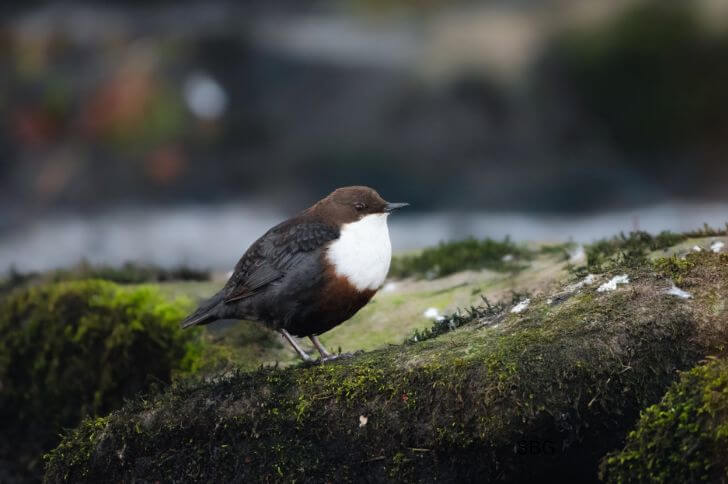
The white throated dipper is a small, sprightly bird that is most often found near fast-flowing mountain streams. These birds are expert swimmers and can often be seen dipping their heads under the water in search of food.
Identification:
Short tailed and rotund, these birds are not easy to spot due to their plumage. Their bodies are a combo of black and brown, giving them a dark brown appearance that allows them to blend in with the surroundings. Their throats and chest are white.
Other facts:
The white throat patch on these birds is a distinctive feature, and they are also known for their loud, clear song. Although they are not shy birds, they can be difficult to spot as they often stay hidden among the rocks near the river.
22. Black-necked Stilt
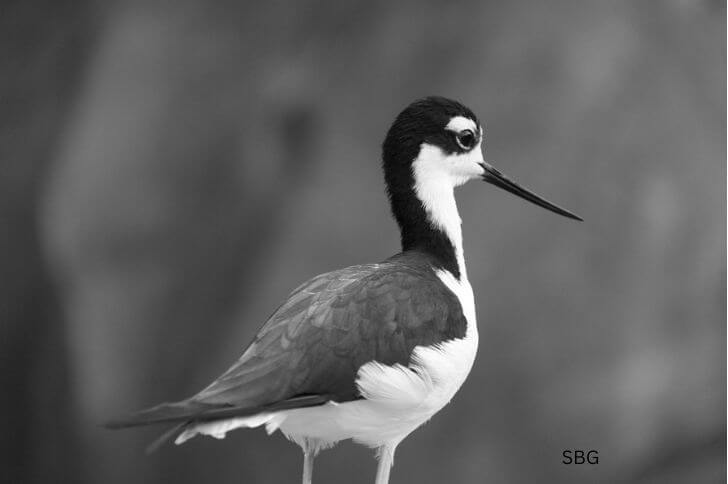
Not to be confused with the black-winged stilt, the Black-necked Stilt is a shorebird with long, thin legs. These striking birds are a beautiful sight to behold as they wade in the shallow water in search of food.
Identification:
How big is a black-necked stilt? These shore birds are about 15 inches long and boast a wingspan of 28-29.5 inches.
Like the stilts above, they are black above, white underneath, and graceful long red legs. Notice their long black bills and striking red eyes.
Other facts:
Black-necked Stilts are found in freshwater wetlands all across North and South America. They are most commonly seen in the western United States, but can also be found in Florida, Hawaii, and even some parts of Mexico and Central America.
These birds breed in colonies near water, oftentimes choosing to build their nests on top of small islands or peninsulas. Both black-necked stilt parents care for chicks.
The Black-necked Stilt is an important part of the wetland ecosystem.
22. Osprey

Identification:
The osprey is a large raptor with dark upperparts and white underparts. It has a wingspan of up to 59-71 inches and a body length of 22–23 inches. The osprey is found on all continents except Antarctica.
The juvenile osprey is duller.
Other facts:
The osprey feeds on fish, which it catches by swooping down over the water and snatching the fish with its talons. Ospreys typically eat one or two pounds of fish per day.
The osprey nests near bodies of water, often in trees or on cliffs. The nest is made of sticks and is lined with leaves, grass, and moss. The female lays 2-4 eggs, which hatch after about 35 days. Both parents feed and protect juvenile ospreys.
23. Hawaiian stilt
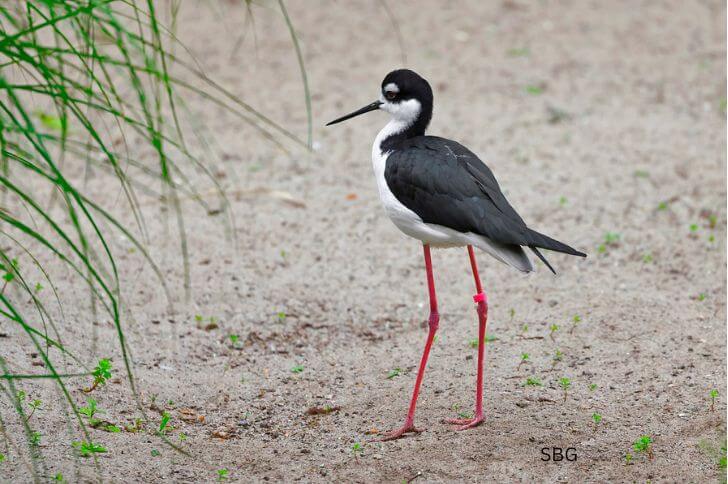
A member of the stilt family, the Hawaiian stilt, or kukuluaeʻo, is a wading bird found only in Hawaii. Unfortunately, like other unique birds of Hawaii, it’s on the verge of extinction.
Identification:
The adult Hawaiian stilt is 15-17 inches long and has black upperparts and wings, with a white breast and belly. The bill is long and thin, and the legs are extremely long, making the bird appear to be quite lanky. The eyes are reddish with a white patch above the eye.
Interesting facts:
The Hawaiian stilt breeds on all of the main islands of Hawaii, except for Kaho’olawe. The primary breeding habitat is freshwater wetlands, such as ponds, lakes, and marshes.
The bird nests in shallow water near the shoreline, typically laying 4 eggs at a time. Their main diet consists of worms, crabs and fish.
24. Black-crowned Night-Heron

The black crowned night heron is a species of heron found in the Americas. How did it get its name? This white breasted black bird gets its name from its habit of hunting early morning or through the night.
Identification:
It is a medium-sized heron with black upperparts and grayish-white underparts. It also has a strong black bill and red eyes. Immature birds are gray-brown with white spots. Their eyes are a bright yellow.
Other facts:
The black crowned night heron is found in both fresh and saltwater habitats. It feeds on fish, crustaceans, and insects. The bird nests in colonies, often near other wading birds.
25. White-breasted Cormorant

Looking for a large black and white bird? The White-breasted Cormorant or the Phalacrocorax lucidus is a species of cormorant found in freshwater and marine habitats across South Africa. Due to their size, they are pretty hard to miss.
Identification:
It is one of the largest members of the Phalacrocoracidae family, with adults averaging 32-39 inches in length and 5 lbs in weight. The plumage of the White-breasted Cormorant is black with a white breast. Note the thick s-shaped neck.
Other facts:
These birds are highly gregarious, forming large colonies during the breeding season. Their diet consists mainly of fish, which they pursue with great agility underwater.
The White-breasted Cormorant has a wide range, encompassing most of South African countries.
Final Thoughts on Black Birds with White Chests
There are numerous types of black birds with white chests. These birds are not only unique to watch but are important to the ecosystem. Whether you are looking to add more birds to your birding journal or just fill a puzzle, this article is perfect for. Not only will you learn their names but also their colors, preferred habitat and breeding season mannerisms.
Sources:
https://mdc.mo.gov/discover-nature/field-guide/eastern-kingbird
https://www.sacramentoaudubon.org/kids-corner/meet-the-black-phoebe
Hi, my name is Steve. My friend and I started the spanishbirdguides.com to share our passion with other like-minded people. So, if bird watching is your thing, you’ll love this blog. I’ll share what I’ve learnt about both local birds and those found in other parts of the world. Also, I’d love to hear your experiences.
